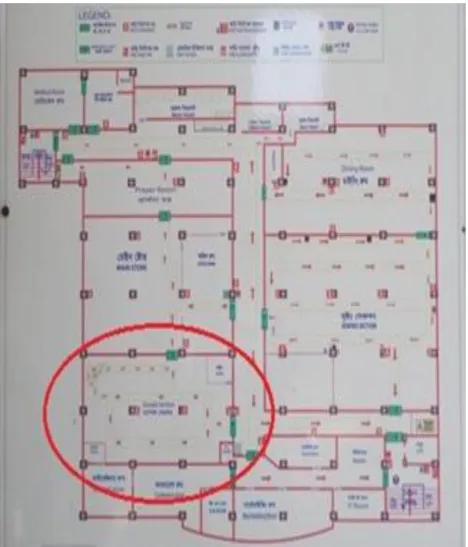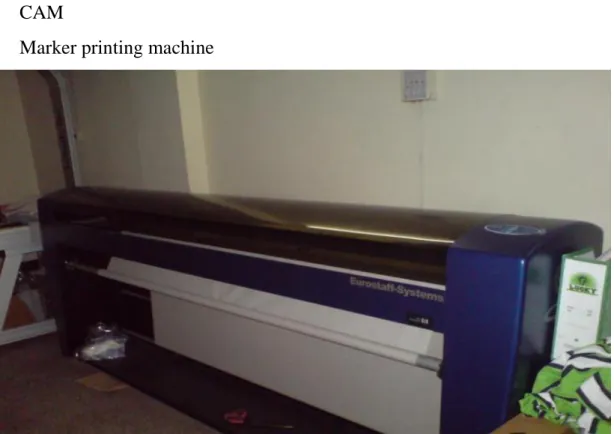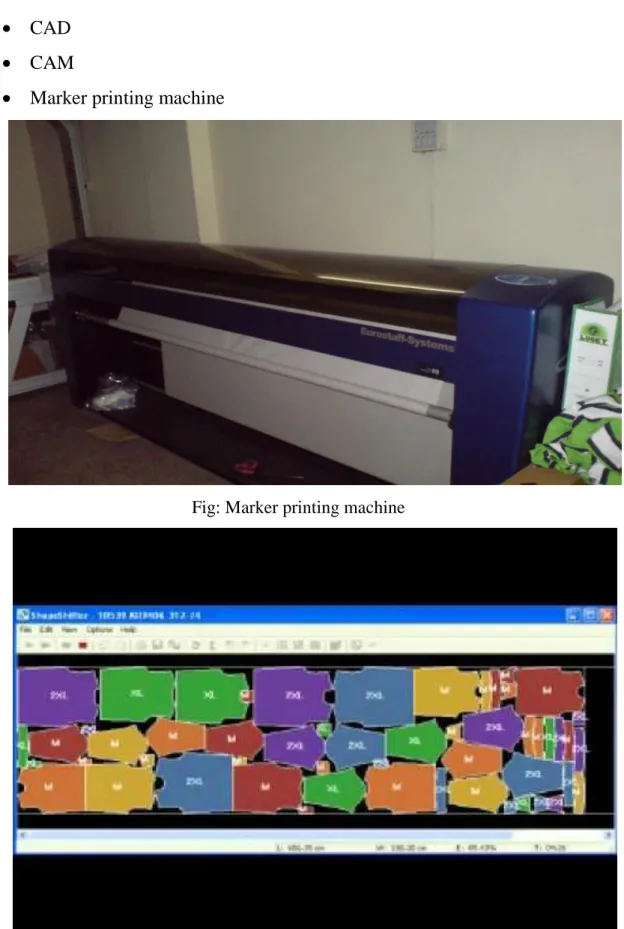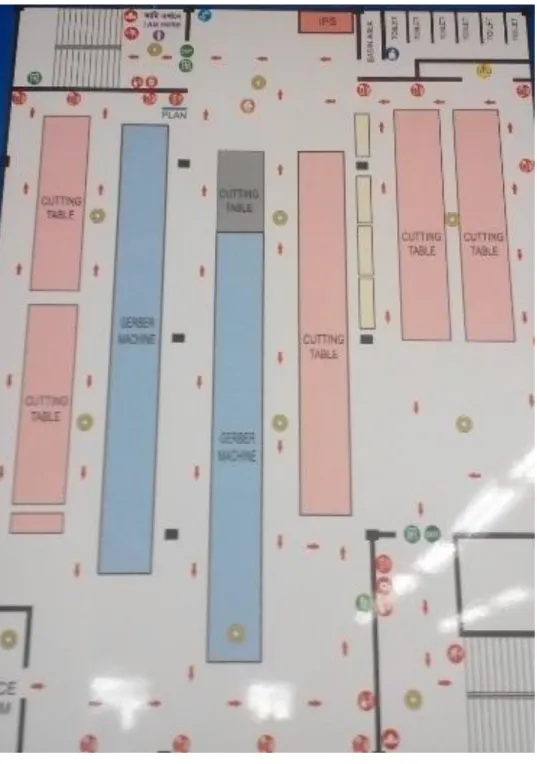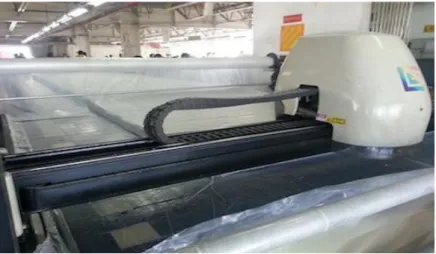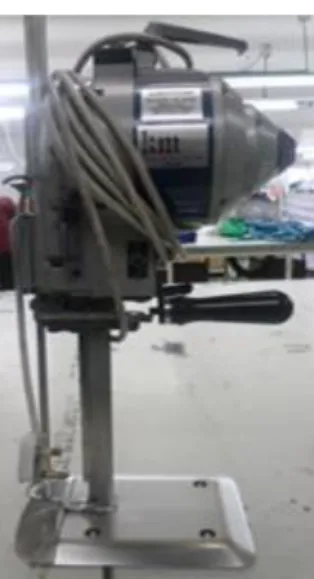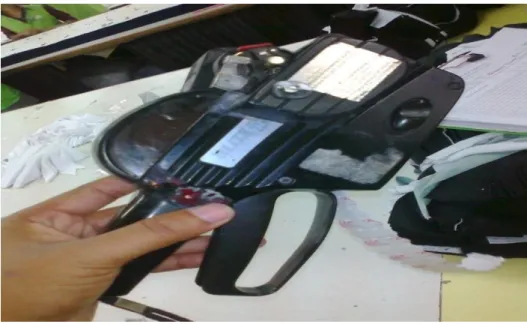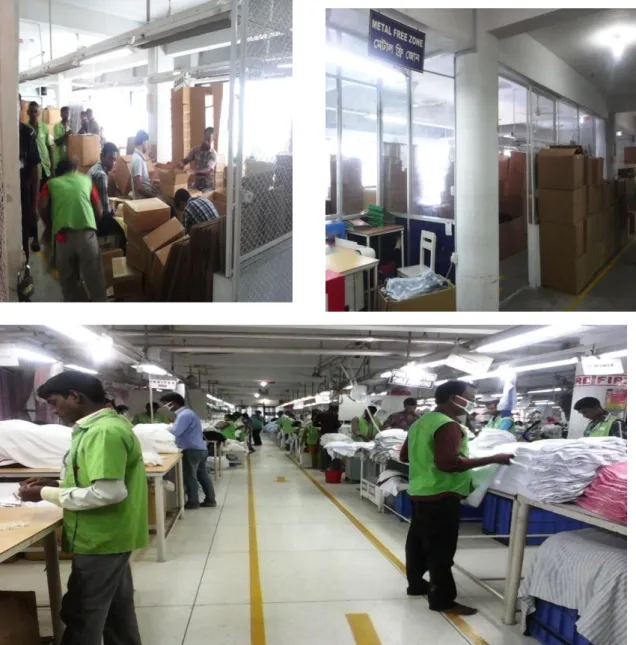© Daffodil International University
Faculty of Engineering
Department of Textile Engineering
REPORT ON
Industrial Attachment At
Robintex Group
Vulta, Rupgonj, Narayangonj
Course Title: Industrial Attachment Course code: TE-
431Submitted By
Shafiqul Islam ID: 113-23-2697 Tanver Ahmed Chowdhury ID: 113-23-2707
Supervised By
Md. Mominur Rahman Senior Lecturer, Dept. of TE
This Report Presented in Partial Fulfillment of the Requirement for the Degree of Bachelor of Science in Textile Engineering
Advance in Apparel Manufacturing Technology
Duration: From May 23, 2015 to July 23, 2015
© Daffodil International University i
DECLARATION
We hereby declare that, this report has been done under the supervision of Md. Mominur Rahman, Senior Lecturer, Department of Textile, Daffodil International University. We also declare that neither this internship report nor any part of this internship report has been submitted elsewhere for award of any degree.
Submitted By
This is to certify that the above declaration made by the candidate is correct to the best of my knowledge.
Supervisor:
_______________________
Md. Mominur Rahman Senior Lecturer,
Department of Textile Engineering Daffodil International University
Internship Period: 23 May – 23 July, 2015
Student Name ID Signature
Shafiqul Islam 113-23-2697
Tanver Ahmed Chowdhury 113-23-2707
© Daffodil International University ii
© Daffodil International University iii
ACKNOWLEDGMENT
At first our gratefulness goes to almighty Allah to give me strength and ability to complete the industrial training and this report. You have made our life more beautiful. May you name be exalted, honored and glorified.
Now we wish to take this excellent opportunity to thank a lot of people who have assisted and inspired us in the completion of our training period:
MD. Mahmudul Hasan, Our industrial supervisor, to whom we are extremely indebted for his tremendous support and guidance throughout our training period. Being working with him we have not only earned valuable knowledge but was also inspired by his innovativeness which helped enrich us experience to a greater extends. His ideas and way of working was truly remarkable.
At the begging we would like to pay our gratitude to Professor Dr. Mahbubul Haque, HEAD, Department of Textile Engineering, Daffodil International University, Prof. Dr. S.M. Mahbub- Ul Haque Majumder, Dean, Faculty of Science & Information Technology, Daffodil International University & Our Academic Supervisor Senior Lecturer Md. Mominur Rahman for giving us all the academic facilities we needed.
We would like to thank all the management of the Robintex Group for giving us the opportunity to do the industrial training successfully and also their valuable suggestion. Our deepest appreciation goes to Mr. A.J.M Abdul Wazed, Mr. Tipu, Mr. Zulfikar, Mr. Masud, Mr.
Mizanur Rahman Gazi, Mr. Iqbal, Mr. Shamim, Mr. Milon (Manager), Comptex Bangladesh Ltd & Robintex Bangladesh Ltd for their permission to conduct our industrial training without which it would be uncompleted . The generous support is greatly appreciated.
We would also like to thanks all Asst. Manager, Sr. Executive, Executive and other officials of Robintex Group for helping us to complete industrial training successfully. Our gratute also goes to all the employers of Robintex Group for their sincere co-operation, support and valuable advice.
© Daffodil International University iv
DEDICATION
Our parents are our life. We love them very much. For completing our study they place very important role. It’s a great pleasure for us. Without their help it is quite impossible for us to complete. So we are very grateful to them. Our parents were very helpful to ready this attachment. And also our honorable teacher & academic supervisor, Senior Lecturer, Md.
Mominur Rahman, Department of Textile Engineering, Daffodil International University, give us a very good support & guideline to ready this attachment. We dedicate this report to our beloved parents.
© Daffodil International University v
TABLE OF CONTENTS Contents Page No.
Declaration………iLetter of Approval………ii
Acknowledgement………...………..…..….iii
Dedication……..………..………..………...iv
Table of Content………v-vi
CHAPTER 01: EXECUTIVE SUMMARY
Executive summary………1CHAPTER 02: PROJECT DESCRIPTION
2.1 Introduction………...………..2-3 2.2 History of the factory……….……….42.3 Founder & directors………5
2.4 General information about factory………...…6
2.5 Layout………
…
………...………...……….72.6 Organogram……...……….………...………...8
2.7 Sister Concerns……….………..9
2.8 Export growth by graph……….………...9
2.9 Product mix………...10
2.10 Factory profile………..………...10-11 2.11 Major buyers with their logo………....12-13 2.12 Certification………..………...14-15 2.13 Mission & Vision………...16
CHAPTER 03: DESCRIPTION OF THE ATTACHMENT
3.1 Sampling 3.1.1 Layout………173.1.2 Organogram………...18
3.1.3 Process Flow Chart………...19
3.1.4 Machineries………...20
3.1.5 Major Operations………...21
3.1.6 Product Evaluation Process………...22
3.2 Cutting 3.2.1 Layout………...23
3.2.2 Organogram………...24
3.2.3 Process Flow Chart………...25
3.2.4 Machineries………...26-27 3.2.5 Major Operations………...28
3.2.6 Product Evaluation Process………...28
© Daffodil International University vi
3.3 Sweing 3.3.1 Organogram………...29
3.3.2 Process Flow Chart………30-31 3.3.3 Machineries………31-32 3.3.4 Major Operations………...32
3.3.5 Product Evaluation Process……….32
3.4 Finishing 3.4.1 Organogram………33-34 3.4.2 Process Flow Chart………..35
3.4.3 Machineries………..36
3.4.4 Major Operations………...36
3.4.5 Product Evaluation Process……….36
3.4.6 Garments Inspection………....37
3.5 Store 3.5.1 Organogram………38-39 3.5.2 Process Flow Chart………...40
3.5.3 Major Operations………...40
3.5.4 Product Evaluation Process………...41
3.6 Maintenance 3.6.1 Organogram………..42-43 3.6.2 Machineries………..44
3.6.3 Major Operations………...45
3.6.4 Product Evaluation Process………..46
CHAPTER 04: IMPACT OF INTERNSHIP
4.1 Impact of sample section………....474.2 Impact of cutting section………...47
4.3 Impact of sewing section………...48
4.4 Impact of finishing section………....49
4.5 Impact of store section………...50
4.6 Impact of maintenance section………...50
CHAPTER 05: CONCLUSION
Conclusion……….…... 51© Daffodil International University 1 | P a g e
1.0 EXECUTIVE SUMMARY
The Industrial Attachment is the most effective way for Textile Engineering student to be achieved the knowledge about the practical field of the Textile Manufacturing. It brings an opportunity to all the learners to enrich their academic knowledge by practicing with the experts of the practical field of textile.
It is my pleasure that I had an opportunity to complete my two months internship at Robintex Group which is one of the most modern industries of the country.
Robintex Group is one of the major garments manufacturing organization in Bangladesh.
This organization increasingly reducing its rejection and rework rate in-process and final garments in order to ensure product quality and delivery time as per buyer requirement and increase profitability. It will ensure sufficient training and suitable work to increase productivity and skills of the employee. Now Robintex Group has a 50 Acres. Its production capacity is around Knitting – 18 tons/day, Dyeing-24ton/day, Finishing-24ton/day, Sewing- 1,00,000 pcs. Number of employees at least 8000.
In this report I tried to cover a short profile of this factory and major customers of Robintex Group and their different activities.
© Daffodil International University 2 | P a g e
2.0 INFORMATION ABOUT FACTORY:
2.1 Introduction
The term “TEXTILE” derived from the Latin Textiles and the French Textiles “to weave”
and it originally referred only to woven fabrics. It has however , come to include fabrics produced by other methods. Thus, threads, cords, ropes, braids, lace, embroidery, nets and fabrics made by weaving, knitting, bonding, felting or tufting are textiles. Some definitions of term textile would also include those products obtained by the papermaking principle that have many of the properties associated with conventional fabrics. In addition to clothing and home furnishings, textile are used for such industrial products as filters to air condoners, life rafts, conveyor belts, tents, automobile tires, swimming pools, safety helmets and mine ventilators.
From fiber to fabric, Robintex Group is truly integrated undertaking. The Robintex Group has the capability to offer a complete product range for the export textile markets. The goal of Robintex Group is to become the preferred partner for sourcing high quality fabrics and clothing from Bangladesh. With highly advanced technology and an emphasis on developing local human resources. Robintex Group has the potential to make an important contribution to the nation’s growing ready made garments export sector.
The rational behind the existing structure and future expansion of Robintex Group is to capture value-added at each stage of textile manufacturing process. Despite
Bangladeshi’s lack of indigenous cotton production capability. Robintex Group has leveraged Bangladeshi’s labor cost advantages and export competitiveness to the maximum.
© Daffodil International University 3 | P a g e
© Daffodil International University 4 | P a g e
2.2 History of the Factory
In 1994 Mr. Firoz-Al Hasan & Shakawat Abu Khair Mohammed establishes the Robintex Knit Dyeing Industry. After then 1st June 2000 they were establish Comptex BD Ltd. In 2005 they were divided into two groups. Mr. Firoz-Al Hasan Youth Group Ltd. & Shakawat Abu Khair Mohammed bought the share of Comptex BD Ltd from Mr. Firoz-Al-Hasan. Then he becomes only one owner of the company. Periodically 2006 establish Printing Section of Robintex Group. And in 2008 new Comptex BD Ltd.
© Daffodil International University 5 | P a g e
2.3 Founder & Directors
01. Founder & Chairman : Sakhawat Abu Khair Mohammed
02. Managing Director : Sakhawat Abu Khair Mohammed
03. Director : Robin Razon Sakhawat
Managing Director Director
Other members
© Daffodil International University 6 | P a g e
2.4 General Information about Factory
Robintex Bd. Ltd. the very first concern of the Group. The company currently employs over 8000 skilled employees. In all the different production with the workers have to go through a process of continuous and rigorous training to maintain a high standard of production set by the management. The group also caters this driving force by ensuring facilities that exceed the minimum set by international regulators. It maintains medical and day care services, scholarship programs and other benevolent initiatives for the employees and their family members. As part of their commitment towards the society, the group has established a medical service station open for all. Robintex Group distributes relief materials including cash to the victims in any part of the country during natural adversities.
© Daffodil International University 7 | P a g e
2.5 Layout
EAST
SOUTH NORTH
WEST
© Daffodil International University 8 | P a g e
2.6 Organogram
GM
DGM
FACTORY MANAGER
ADMINISTRATION MANAGER
PRODUCTION MANAGER
CUTTING MANAGER
QUALITY MANAGER
SHIFT IN-CHARGE
FLOOR IN-CHARGE
SUPERVISOR
LINE CHIEF
© Daffodil International University 9 | P a g e
2.7 Sister Concerns:
Robintex Bd. Ltd.
Robintex Knitwear Ltd.
Comptex Bd. Ltd.
2.8 Export Growth by Graph:
Export growth of Robintex Group
© Daffodil International University 10 | P a g e
2.9 Product Mix
Basic T-Shirt
Tank Top
Long Sleeve
T-Shirt
Polo Shirt
Trouser
Ladies, kids Knitwear all kinds of knit garments & knit fabric.2.10 Factory Profile
Name of the Company : Robintex Group
(Comptex BD Ltd. & Robintex BD Ltd.)
Address :
Head office : TK Bhavan
(8th Floor)
13, Karwan Bazar, Kazi Nazrul Islam Avenue, Dhaka-1215, Bangladesh.
Tel : +88-02-9138162 Fax: +88-02-9117751 E-mail : [email protected]
[email protected] www.robintexbd.com
Factory : Vulta, Rupgonj, Narayongonj.
Type of the project : 100% Export Oriented Composite Knit Industry (German-Bangladesh Joint Venture).
Year of Establishment : Robintex 1994
Comptex 2004
Investor : Sakhawat Abu Khair Mohammed
Factory Area : 50 Acres
© Daffodil International University 11 | P a g e Total Employees : 8000 person
Annual Turnover : 120 core Tk
Certification & Awards : ISO 9001 Certified; Control Union Certificate;
OEKOTEX Certificate; Organic Cotton Certificate
Main Product : Basic T-Shirt, Tank Top , Long Sleeve, T-Shirt, Polo Shirt,
Trouser, Ladies & Kids Knitwear all kinds of knit garments & knit fabric.
Production Capacity : Knitting – 18 tons/day Dyeing-24ton/day Finishing-24ton/day Sewing-1,00,000 pcs
© Daffodil International University 12 | P a g e
2.11 Main Buyers
© Daffodil International University 13 | P a g e
H & M
HEMA
ITPS
Slazenger
Tom-tailor
PUMA
© Daffodil International University 14 | P a g e
2.12 Certification
ISO 9001 Certified
Control Union Certificate
OEKOTEX Certificate
Organic Cotton Certificate
© Daffodil International University 15 | P a g e
© Daffodil International University 16 | P a g e
2.13 Mission & Vision
Mission: Robintex Group believe that the final analysis it is accountable to each of constituents with whom it interact, namely , its employees , customer, business associates, fellow and citizens.
Vision: To be one of the best leading composite mill in Bangladesh. To build a true marketing lead enterprise with motivates workforce, innovative mission and understanding global market.
© Daffodil International University 17 | P a g e
03 DESCRIPTION OF THE ATTACHMENT
3.1 Sampling
3.1.1 Layout:Fig: Layout plan of sample section
© Daffodil International University 18 | P a g e 3.1.2 Organogram:
Asst. Manager Jr. Manager Executive Sr. Executive
Officer Supervisor
Sr. Marker Man Marker Man
Wheel Man Sample Man Cutting Man Cutting Asst.
Iron Man &
Folder Man
© Daffodil International University 19 | P a g e 3.1.3 Process Flow Chart:
Sketch/design
(It is given by buyer for make sample and products are made according to that style of designed)
Basic block
(Without any allowance)
Working pattern
(To make of garment according to design)
Sample making
(Sample is made by sample man)
Basic manufacturing difference (Critical path is identify)
Approved sample (Sample approved by buyer)
Costing
(To estimate the making charge, trimming, fabric required and profit)
© Daffodil International University 20 | P a g e 3.1.4 Machineries:
CAD
CAM
Marker printing machine
Fig: Marker printing machine
Fig: CAD software
© Daffodil International University 21 | P a g e 3.1.5 Major operations:
Design or Sketch:
It is nothing but one kind of engineering art including all measurement of particular style.
Basic Block:
It is an individual component of garments without any design or style.
Working Pattern:
To make pattern for a particular style with net dimension. .
Problem of Production or Production Related Matter:
Production related problems should be eliminated in this step.
Approved Sample:
The sample which is approved by buyer is called approved sample.
Send to Buyer:
When all process is done, then the garments are sent to buyer.
Production Pattern:
To make pattern for a particular style with net dimension along with allowance.
© Daffodil International University 22 | P a g e 3.1.6 Product evaluation process:
Gain a full understanding of the sample development process.
Able to plan a development process suitable for your company.
Awareness of reducing development and company costs and improve customer service.
Find ways of minimizing risk factors and maximizing quality parameters.
Economic/market place needs are identified.
Forming first concepts/ideas.
Developing concepets into prototype sample
Modifying prototype untill approved.
Amendments to specification.
Finalized first sample & specification to retailing.
© Daffodil International University 23 | P a g e
3.2 Cutting
3.2.1 Layout:Fig: Layout plan of cutting section
© Daffodil International University 24 | P a g e 3.2.2 Organogram:
Deputy Manager Jr. Manager Executive
Asst. Supervisor Lay Man Stripe/SCR Man
Cutter Asst. Cutter Loder
Others
© Daffodil International University 25 | P a g e 3.2.3 Process Flow Chart:
Table cleaning
Paper spreading
Gum tape attach
Fabric spreading
Marker checking on lay
Spreading finish
Marker spreading
Marker tearing
Gum Tape attaching
Cutting
Stickering
Bundling
Cut panel checking
Ready for Sewing
© Daffodil International University 26 | P a g e 3.2.4 Machineries:
1. Cutting machine:
a) Manual cutting machine-
i) Straight knife cutting machine ii) Hand operated cutting scissor
Fig: Straight knife cutting machine b) Computerize cutting machine-
i) Gerber auto cutting machine ii) EMM auto cutting machine
Fig: Computerized cutting machine
© Daffodil International University 27 | P a g e 2. Fabric spreading machine
i) Gerber auto spreading machine ii) EMM auto spreading machine
Fig: Auto spreading machine 3. Fabric spreading table
4. Numbering machine
Fig: Numbering machine
© Daffodil International University 28 | P a g e
3.2.5 Major Operations:
All documents check-
a) Shade approval
b) 4 point inspection report c) GSM report
d) Shrinkage test report e) Country plane f) Relaxation sticker
Fabric spreading
Marker check
Fabric cutting
Block check by pattern
Cut panel check
3.2.6 Product Evaluation process:
Shade check with buyer approved swatch
Check GSM
Running shade check
Roll wise shade check
Batch to batch shade check
Shrinkage test
Marker check
Cutting panel check
Pattern check
Shape check of different parts
Measurement check
Check number of different parts in bundle
© Daffodil International University 29 | P a g e
3.3 Sewing
3.3.1 Organogram:
FactoryMana ger
Factory In- Charge
Deputy Manager
Asst.
Manager
Jr. Manager Executive
Executive Sr. Supervisor
Supervisor Asst.
Supervisor Operator Asst.
Operator
Helper
© Daffodil International University 30 | P a g e 3.3.2 Process Flow Chart:
Attend pre-production meeting
Receive sample
Receive work sheet
Receive Approved swatch
Operation Break-down
Machine layout
Receive cut Fabric from cutting section by using Receiving Register
Receive Sewing pattern from pattern maker
Marking at necessary parts
Input
First production approved by Q.C. department
Look after production
Cycle check
Line Balancing
Target setting
Co-operative with Q.C. Department
© Daffodil International University 31 | P a g e Hand over complete Garments to finishing section through end line Q.C. Inspector
Show hourly production on production board
Prepare every day input and production statement
Maintain discipline and working environs
3.3.3 Machineries:
Over lock
Single needle
Flat lock
Button stitch
Button holing
Piping cutter
Bartek
Kansai
Snap button
Fig: Plain machine Fig: Over lock machine
© Daffodil International University 32 | P a g e Fig: Bartek machine
3.3.4 Major operations carried out by the section:
Collect counter sample
Take cut panel measurement
Front / back matching
Start sewing
Use mockup for critical operation
Process wise thread trimming & cutting sticker remove
Process quality check
End table quality check
3.3.5 Product evaluations carried out by the process:
Calculate the production capacity
To establish proper layout of the sewing floor
To provide accurate guideline for the floor supervisor ,floor quality ,line chief and other person of the floor
To solve any problem of the floor, it may production problem, worker problem etc.
To provide production report and other information in the floor of the higher authority
To look after the floor
To maintain the line chief line quality ,line supervisor and other persons of the floor
To solve any problem of any line in the sewing floor
To maintain line input and output materials
To find out per line production capacity of the sewing floor
© Daffodil International University 33 | P a g e
3.4 Finishing
Fig: Finishing section
© Daffodil International University 34 | P a g e Deputy Manager Sr. Executive
Supervisor (16) Iron Man (90)
Metal m/c (10) Packing (40)
Ply and folding (160) Loader (13)
Spot Wash (15) L.N.D (10)
3.4.1 Organogram:
© Daffodil International University 35 | P a g e Ready For Shipment
Cartooning Metal Detection
QA Supervision Poly Packing
Assortment Folding QA Inspection Accessories Attatch
Getup Check Mesurement Check
Quality Check
Sewing Defect Check Spot Defect Check Ironing
3.4.2 Process Flow Chart:
© Daffodil International University 36 | P a g e 3.4.3 Machineries:
Heat iron
Steam iron
Metal detector
Neck press
Thread sucker
3.4.4 Major operations:
Thread Suction (Thread Sucker M/c)
Ironing
Quality Check
Metal detection
Accessories Attach (Hang Tag, Price Tag, Hanger, Sticker, Security Alarm etc.)
QA Inspection
Folding/Rolling
QA Supervision
Cartooning/Packaging 3.4.5 Product evaluation process:
Getup check
Measurement check
Final garments inspection
Ratio wise packing inspection
© Daffodil International University 37 | P a g e 3.4.6 Garment Inspection:
Flow Chart of Garment Inspection
Confirmation of Quantity
↓
Confirmation of accessories
↓
Size specification inspection
↓
In side Inspection
↓
Outside Inspection
↓
Final Inspection
↓ Packing
© Daffodil International University 38 | P a g e
3.5 Store Section
Fig: Store section
Fig: Store section
© Daffodil International University 39 | P a g e Manager
Jr. Manager(2)
Executive(1) Sr. Officer(3) Officer(10)
Jr. Officer(2)
Store Asst.(15) Loader(24)
Driver(1)
L.N.D(6)
3.5.1 Organogram:
© Daffodil International University 40 | P a g e 3.5.2 Process Flow chart:
Booking materials (by merchandiser according to style wise)
Receive materials (style wise)
Inspections (ok / reject)
Inventory (If ok)
Check (invoice packing / receipt)
Delivery on the floor (according to need of the floor)
3.5.3 Major Operations:
a) Fabric Received b) Fabric inspection c) Fabric inventory d) Shrinkage test of fabric e) Shade grouping of fabric f) Color continuity card
g) Fabric assessment with light h) Swatch card maintain
© Daffodil International University 41 | P a g e 3.5.4 Production Evaluation:
Store the fabric before production
Knock the suppliers for delivery accessories at time
Store the fabric after quality and quantity checking
Maintaining inventory report
Supply the materials through the sub-store(sewing floor) with the document (chalan)
Giving input report to R&D
© Daffodil International University 42 | P a g e
3.6 Maintenance
© Daffodil International University 43 | P a g e 3.6.1 Organogram:
Sr. Vice President
Asst. Vice President
Vice President Maintenance
Maintenance Incharge
Mechanical Incharge
Sub Asst.
Engineer
Foreman
Technicain
Electrical Incharge
Supervisor
Sr. Elecricain
Electrician
Vice President Utility
© Daffodil International University 44 | P a g e 3.6.2 Machineries:
1. Combination tools / spanner 2. Socket ratchet set
3. Slide range 4. Monkey pliers
5. Pipe threat cutting tools 6. Bearing puller
7. Pipe range
8. Pipe cutting tools 9. Hole punch 10. Divider 11. Easy opener 12. External threat die 13. Heavy scissor 14. Oil can
15. Drill machine and drill bit.
16. Grease gun 17. Grinding m/c 18. Welding m/c 19. Spirit leveler 20. File
21. Hammer 22. Circlip tools 23. Hacksaw blade 24. Handsaw (wood)
© Daffodil International University 45 | P a g e 3.6.3 Major Operations:
Metal cutting.
Scaling & right angling.
Perfect leveling.
Welding & cutting.
Grinding & cutting of mild steel.
Greasing of moving parts of m/c.
Drilling.
Oiling of moving parts.
Tightening & loosening of nuts & bolts.
Tightening of nuts & bolts
Tightening & loosening of nuts & bolts.
Tightening & loosening of nuts & bolts.
Cut the threat in pipe.
Cutting of gasket & steel sheet.
External threat cutting.
Open the broken head bolt.
Circle marking on metal & wood.
Punching the hole.
Assist the opening of bearing from shaft.
Tightening & loosening of pipe joint.
Pipe cutting.
© Daffodil International University 46 | P a g e 3.6.4 Product Evaluation Process:
By keeping the factory plants, equipment’s, machine tools in an optimum working condition.
By ensuring specified accuracy to product and time schedule of delivery to customer.
By keeping the downtime of machines to the minimum thus to have control over the production program.
By keeping the production cycle within the stipulated range.
By modifying the machine tools to meet the need for production
By improving productivity of existing machines and to avoid sinking of additional capital.
By reducing the maintenance cost as far as possible thereby leading to reduction in factory overhead
By prolonging the useful life of the factory plant and machinery by retaining their acceptable level of accuracy of performance.
© Daffodil International University 47 | P a g e
04 IMPECT OF INTERNSHIP
4.1 Impact of Sample Section
Understood why sample section is called a mini-industry.
Observed how skilled workers work in sample section.
Learned the process of preparing a pattern for an individual size & design.
Cleared the conception about different types of sample required to produce a garment.
Learned about the digitizing board in CAD room.
Learned the process of determining breakdown ratio for a particular order.
Understood how to make marker from a pattern by software (Investronica) in CAD room.
Observed the process of printing a marker on a paper with plotter machine in CAD room.
4.2 Impact of Cutting Section
Learned about different type of cutting machines (i.e. Straight knife cutting machine, Round knife cutting machine, Band knife cutting machine etc.).
Learned the process of fabric spreading.
Observed the process of fabric cutting according to the marker.
Understood different process of fabric lay.
Realized the use and importance of metal gloves for fabric cutting process through different cutting machines.
Observed the panel check process for different type of fabric of different style and design.
Understood how numbering and bundling is done.
© Daffodil International University 48 | P a g e
4.3 Impact of Sewing Section
Learned about different parts of a shirt (i.e. Upper front, Lower front, and back part, Facing, Collar and Sleeve etc.).
Observed different sewing or joining process of different body parts of a shirt.
Learned about different type of machines used in a sewing floor (i.e. Single or double needle lock stitch machine , Multi needle chain stitch machine, Over lock machine, Feed of the arm machine etc.).
Observed the ironing and fusing process for different body parts (i.e. Collar, Placket, Facing Interlining etc.).
Learned about Standard Minute Value (SMV) of different sewing process.
Learned the process of determining operator’s efficiency in an individual process for a shirt.
Cleared the conception about production of a sewing floor (line by line and total floor).
Observed and realized the importance of final inspection at the end of every sewing line.
Got experienced in making production study of an operator for an individual process for a definite time interval.
Also got experienced in making capacity graph of a sewing line of a definite style and design.
Attended Pre-production meeting before the bulk production of an order.
Realized the importance of Dept. of IE in raising the efficiency of production in a sewing floor.
© Daffodil International University 49 | P a g e
4.4 Impact of Finishing Section
Observed various type of finishing process after sewing and washing.
Observed different type of machines used in finishing section (i.e. Neck press machine, Metal detector machine etc.).
Learned about different type of iron machines.
Learned about various type of accessories used to attach to the garment (i.e. Security alarm, Hang tag, Price tag, Barcode label etc.).
Observed the application of different chemicals for the removal of various type of stain.
Observed and learned different type of folding process (i.e. Standard fold, Semi- standard fold, Hanger fold, Twill fold, half fold, Full fold etc.).
Cleared the conception about different packing type (i.e. Master pack, Blister pack, Coffin pack etc.) and packing ratio.
Understood the basic difference between gross weight and net weight.
Finally realized why finishing section is unavoidable in garments industry for making the garment attractive and decorative for selling purpose.
© Daffodil International University 50 | P a g e
4.5 Impact of Store Section
Understood the necessity & process of inventory.
Learned how an order is confirmed via merchandiser.
Realized the role of PI (Pro-forma Invoice).
Had cleared the conception about fabric inspection method.
Learned how to examine AQL in a fabric lot.
Learned the procedure of determining shade variation in fabric through light cabinet.
Understood the system of preparing color continuity card.
Learned the procedure of receiving materials & dispatching goods outside of the factory.
4.6 Impact of Maintenance Section:
Learned about the accuracy to product and time schedule of delivery to customer.
Understood how to modify the machine tools to meet the need for production
Learned about the production cycle
Understood how to improve productivity of existing machines
Understood the way to reduce the maintenance cost as far as possible
© Daffodil International University 51 | P a g e
05. CONCLUSION
The industrial training gives us the first opportunity to work in mills. It was a practical experience beyond the normal academic learning. This training gave us actual picture about man, machine, money, material, method and market and interdependence. We have earn the direct practical knowledge about the raw materials, actual running condition of the machine, works of technologist, administration. Industrial training is an essential part for textile education because it minimizes the gap between theoretical and practical knowledge and also increase our thinking level about textile technology.
We have completed our industrial attachment from Robintex Group during two-month long industrial training at Robintex Group. We got the impression that this factory is one of the modern export oriented composite knit garments industry in our Bangladesh. This factory does not compromise in case of quality. Due to this, it has earned a “very good reputation” in foreign market for its quality product over many other export oriented textile mills. It has very well educated and technically experienced manpower to get rid of any defect in production process. It has also organizational hierarchy.
